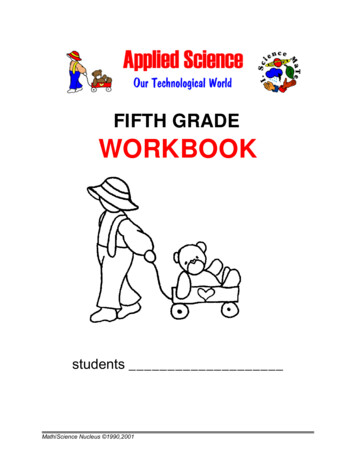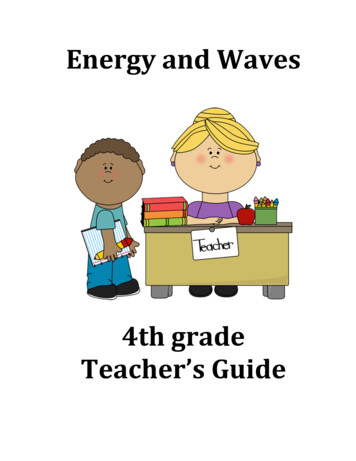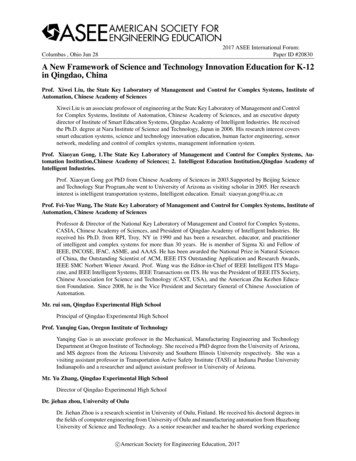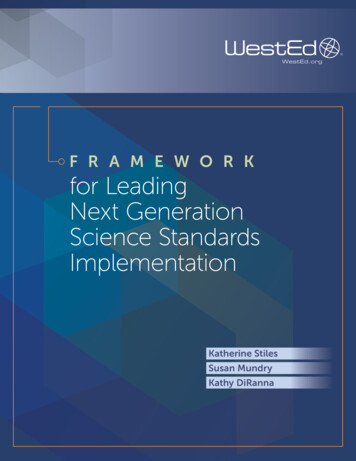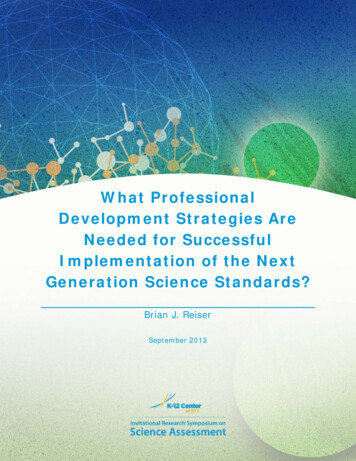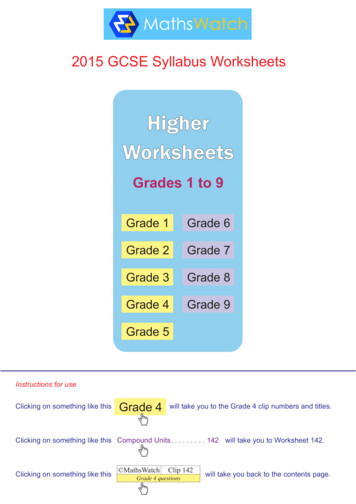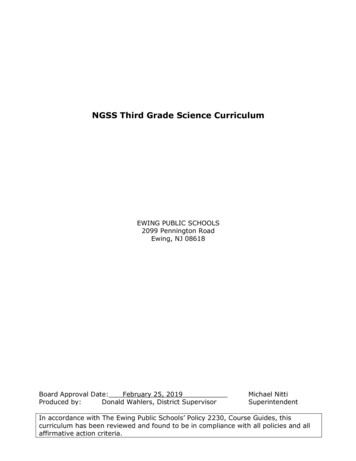
Transcription
NGSS Third Grade Science CurriculumEWING PUBLIC SCHOOLS2099 Pennington RoadEwing, NJ 08618Board Approval Date:February 25, 2019Produced by:Donald Wahlers, District SupervisorMichael NittiSuperintendentIn accordance with The Ewing Public Schools’ Policy 2230, Course Guides, thiscurriculum has been reviewed and found to be in compliance with all policies and allaffirmative action criteria.
Table of ContentsPageCourse Description and Rationale 321st Century Life and Careers .4Unit 1: Forces and Interactions 9Unit 2: Interdependent Relationships in Ecosystems 13Unit 3: Inheritance and Variations of Traits: Life Cycles and Traits 17Unit 4: Weather and Climate 21Sample Standard Integration 24
Course Description and RationaleStudents in this course will learn to explain scientific phenomena. The NextGeneration Science Standards (NGSS) performance expectations rely on threedimensions of learning to develop student understanding of scientific concepts. Coreconceptual ideas are learned by engaging in scientific and engineering practices andconsidering crosscutting concepts. These three dimensions support students indeveloping useable knowledge to explain real world phenomena in the sciences.In science, performance expectations at the elementary school level use threedimensional learning to foster student understanding of science concepts.Students will use the following eight NGSS Science and Engineering Practices todemonstrate understanding of the disciplinary core ideas and develop critical thinkingskills: Asking questions (science) and defining problems (engineering) Developing and using models Planning and carrying out investigations Analyzing and interpreting data Using math and computational thinking Constructing explanations (science) and designing solutions (engineering) Engaging in argument from evidence Obtaining, evaluating, and communicating informationThe following seven crosscutting concepts support the development of a deeperunderstanding of the disciplinary core ideas: Patterns Cause and effect: mechanism and explanation Scale, proportion, and quantity Systems and system models Energy and matter: flows, cycles and conservation Structure and functionThe course is a year-long course that meets for 45 minutes per day, on average forhalf the days of each marking period. The course uses a project-based approach toexploring many concepts. Many of the core ideas will be applied to engineeringproblems, allowing students to also develop an understanding of the engineeringdesign process. This will further develop problem-solving and critical thinking skills asstudents work to design, test, solve, and revise solutions to problems. Thecrosscutting concepts of patterns through structure and function are used asorganizing concepts for these disciplinary core ideas. These performance expectationsfocus on students demonstrating proficiency in developing and using models, usingmathematical thinking, and obtaining, evaluating and communicating information;and to use these practices to demonstrate understanding of the core ideas.The course content is arranged into four units of study: Forces and InteractionsInterdependent Relationships in EcosystemsInheritance and Variation of Traits: Life Cycles and TraitsWeather and Climate3
21st Century Skills - During this course, students will work on developing, to an ageappropriate level, the following 21st century skills:Career Readiness Pathways: CRP4. Communicate clearly and effectively and with reason. CRP5. Consider the environmental, social and economic impacts of decisions. CRP6. Demonstrate creativity and innovation. CRP7. Employ valid and reliable research strategies. CRP8. Utilize critical thinking to make sense of problems and persevere insolving them.21st Century Themes:Global Awareness: Using 21st century skills to understand and address global issuesEnvironmental Literacy: Demonstrate knowledge and understanding of the environment and thecircumstances and conditions affecting it, particularly as relates to air, climate,land, food, energy, water and ecosystems Demonstrate knowledge and understanding of society’s impact on the naturalworld (e.g., population growth, population development, resource consumptionrate, etc.) Investigate and analyze environmental issues, and make accurate conclusionsabout effective solutions Take individual and collective action towards addressing environmentalchallenges (e.g., participating in global actions, designing solutions that inspireaction on environmental issues)Learning and Innovation SkillsCreativity and InnovationThink Creatively Elaborate, refine, analyze and evaluate their own ideas in order toimprove and maximize creative effortsWork Creatively with Others View failure as an opportunity to learn; understand that creativity andinnovation is a long-term, cyclical process of small successes andfrequent mistakes4
Critical Thinking and Problem SolvingReason Effectively Use various types of reasoning (inductive, deductive, etc.) asappropriate to the situationUse Systems Thinking Analyze how parts of a whole interact with each other to produce overalloutcomes in complex systemsMake Judgments and DecisionsEffectively analyze and evaluate evidence, arguments, claims and beliefsSynthesize and make connections between information and argumentsInterpret information and draw conclusions based on the best analysisSolve Problems Identify and ask significant questions that clarify various points of viewand lead to better solutionsCommunication and CollaborationCommunicate Clearly Articulate thoughts and ideas effectively using oral, written andnonverbal communication skills in a variety of forms and contexts Listen effectively to decipher meaning, including knowledge, values,attitudes and intentions Use communication for a range of purposes (e.g. to inform, instruct,motivate and persuade) Utilize multiple media and technologies, and know how to judge theireffectiveness a priori as well as assess their impact Communicate effectively in diverse environments (including multilingual)Collaborate with Others Assume shared responsibility for collaborative work, and value theindividual contributions made by each team member5
Information, Media, and Technology SkillsInformational LiteracyAccess and Evaluate Information Evaluate information critically and competentlyUse and Manage Information Use information accurately and creatively for the issue or problem athand6
Life and Career SkillsSocial and Cross-Cultural SkillsInteract Effectively with Others Know when it is appropriate to listen and when to speakWork Effectively in Diverse Teams Respond open-mindedly to different ideas and valuesBe Responsible to Others Act responsibly with the interests of the larger community in mindTechnology Integration8.1 Educational TechnologyAll students will use digital tools to access, manage, evaluate, and synthesizeinformation in order to solve problems individually and collaborate and create andcommunicate knowledge.ELA Integration: NJSLS.RI.3.1 Ask and answer questions to demonstrate understanding of atext, referring explicitly to the text as the basis for the answers. (3-ESS2-2)(3-LS2-1) (3-LS4-1) (3-LS4-3) (3-LS4-4) (3-PS2-1) (3-PS2-3)NJSLS.RI.3.2 Determine the main idea of a text; recount the key details andexplain how they support the main idea. (3-LS4-1) (3-LS4-3) (3LS4-4)NJSLS.RI.3.3 Describe the relationship between a series of historical events,scientific ideas or concepts, or steps in technical procedures in a text, usinglanguage that pertains to time, sequence, and cause/effect. (3-LS2-1) (3-LS41) (3-LS4-3) (3-LS4-4) (3-PS2-3)NJSLS.RI.3.7 Use information gained from illustrations (e.g., maps,photographs) and the words in a text to demonstrate understanding of the text(e.g., where, when, why, and how key events occur). (3-LS1-1)NJSLS.RI.3.8 Describe the logical connection between particular sentencesand paragraphs in a text (e.g., comparison, cause/effect, first/second/third in asequence). (3-PS2-3)NJSLS.RI.3.9 Compare and contrast the most important points and keydetails presented in two texts on the same topic. (3-ESS2-2)NJSLS.SL.3.3 Ask and answer questions about information from a speaker,offering appropriate elaboration and detail. (3-PS2-3)NJSLS.SL.3.4 Report on a topic or text, tell a story, or recount an experiencewith appropriate facts and relevant, descriptive details, speaking clearly at anunderstandable pace. (3-LS3-1) (3-LS3-2) (3-LS4-2) (3-LS4-3) (3-LS4-4)NJSLS.SL.3.5 Create engaging audio recordings of stories or poems thatdemonstrate fluid reading at an understandable pace; add visual displays whenappropriate to emphasize or enhance certain facts or details. (3-LS1-1)NJSLS.W.3.1 Write opinion pieces on topics or texts, supporting a point ofview with reasons. (3-ESS3-1) (3-LS2-1) (3-LS4-1) (3-LS4-3) (3-LS4-4)7
NJSLS.W.3.2 Write informative/explanatory texts to examine a topic andconvey ideas and information clearly. (3-LS3-1) (3-LS3-2)(3-LS4-1) (3-LS4-2)(3-LS4-3) (3-LS4-4)NJSLS.W.3.7 Conduct short research projects that build knowledge about atopic. (3-ESS3-1) (3-PS2-1) (3-PS2-2)NJSLS.W.3.8 Recall information from experiences or gather information fromprint and digital sources; take brief notes on sources and sort evidence intoprovided categories. (3-PS2-1) (3-PS2-2)NJSLS.W.3.9 Recall information from experiences or gather information fromprint and digital sources; take brief notes on sources and sort evidence intoprovided categories. (3-ESS2-2) (3-LS4-1)Mathematics Integration: NJSLS.MP.2 Reason abstractly and quantitatively. (3-ESS2-1) (3-ESS2-2) (3ESS3-1) (3-LS4-1) (3-LS4-4) (3-PS2-1)NJSLS.MP.4 Model with mathematics. (3-ESS2-1) (3-ESS2-2) (3-ESS3-1) (3LS2-1) (3-LS4-1),(3-LS4-4)NJSLS.MP.5 Use appropriate tools strategically. (3-ESS2-1) (3-LS4-1) (3-PS21)NJSLS.3.MD.A.2 Measure and estimate liquid volumes and masses of objectsusing standard units of grams (g), kilograms (kg), and liters (l). Add, subtract,multiply, or divide to solve one-step word problems involving masses orvolumes that are given in the same units, e.g., by using drawings (such as abeaker with a measurement scale) to represent the problem. (3-ESS2-1) (3PS2-1)NJSLS.3.MD.B.3 Draw a scaled picture graph and a scaled bar graph torepresent a data set with several categories. Solve one- and two-step “howmany more” and “how many less” problems using information presented inscaled bar graphs. (3-ESS2-1) (3-LS4-2) (3-LS4-3)NJSLS.3.MD.B.4 Generate measurement data by measuring lengths usingrulers marked with halves and fourths of an inch. Show the data by making aline plot, where the horizontal scale is marked off in appropriate units—wholenumbers, halves, or quarters. (3-LS3-1) (3-LS3-2) (3-LS4-1)NJSLS.3.NBT Number and Operations in Base Ten (3-LS1-1) (3-LS2-1)NJSLS.3.NF Number and Operations—Fractions (3-LS1-1)8
Unit 1: Forces and InteractionsRecommended Pacing - 22 daysWhy Is This Unit Important?This unit targets three major areas of Forces and Interactions: Students are able to determine the effects of balanced and unbalanced forceson the motion of an object.Students are able to determine the cause and effect relationships of electric ormagnetic interactions between two objects not in contact with each other.Students are able to apply their understanding of magnetic interactions todefine a simple design problem that can be solved with magnets.Enduring Understandings: Each force acts on one particular object and has both strength and a direction.An object at rest typically has multiple forces acting on it, but they add to givezero net force on the object.Forces that do not sum to zero can cause changes in the object’s speed ordirection of motion.The patterns of an object’s motion in various situations can be observed andmeasured; when that past motion exhibits a regular pattern, future motion canbe predicted from it.Objects in contact exert forces on each other.Electric and magnetic forces between a pair of objects do not require that theobjects be in contact.The sizes of the forces in each situation depend on the properties of the objectsand their distances apart and, for forces between two magnets, on theirorientation relative to each other.Patterns of change can be used to make predictions.Cause and effect relationships are routinely identified, tested, and used toexplain change.Science findings are based on recognizing patterns.Science investigations use a variety of methods, tools, and techniques.Essential Questions: What is force?What is net force?How can you change the speed of an object?How can you change the direction of motion of an object?What are the ways that speed can change?What are contact forces?How can objects affect each other when not in contact?What is an electrical force?What is a magnetic force?What affects the size of a force?How do equal and unequal forces on an object affect the object?How can magnets be used?”9
Acquired Knowledge: A force is a push or a pullPushes and pulls have strength.Pushes and pulls can have a direction.Pushing or pulling on an object can change the speed and direction of itsmotion.The motion of an object is determined by the total of all forces on it.There are two types of magnetic poles; north and southMagnetic force is the push or pull between two magnetic poles.Opposite poles pull on each other; the same type of poles push on each otherThere are two types of charges; positive and negative.Electrical force is the push or pull between two magnetic poles.Opposite charges pull on each other; the same type of charges push on eachother.The factors that affect the strength of a magnetic force are:o Magnetic pole strengtho How close the poles are to one anotherThe factors that affect the strength of an electrical force are:o Electric charge strengtho How close the charges are to one anotherAcquired Skills: Ask questions that can be investigated based on patterns such as cause andeffect relationships.Define a simple problem that can be solved through the development of a newor improved object or tool.Plan and conduct an investigation collaboratively to produce data to serve asthe basis for evidence, using fair tests in which variables are controlled and thenumber of trials considered.Make observations and/or measurements to produce data to serve as the basisfor evidence for an explanation of a phenomenon or test a design solution.Assessments:Formative Assessments: Group discussions/presentations:o Propose higher order questionso Present information to students and ask a questiono Have students discuss their answers with their peers at their tableand discuss together as a group10
Summative Assessments: Projects:o Determine Cause and Effect Relationshipso Define and Solve a Design ProblemBenchmarks: Students will be assessed on their ability to plan and conduct aninvestigation to provide evidence of the effects of balanced and unbalancedforces on the motion of an object. [Clarification Statement: Examples couldinclude an unbalanced force on one side of a ball can make it start moving;and, balanced forces pushing on a box from both sides will not produce anymotion at all.] [Assessment Boundary: Assessment is limited to onevariable at a time: number, size, or direction of forces. Assessment doesnot include quantitative force size, only qualitative and relative. Assessmentis limited to gravity being addressed as a force that pulls objects down.]Students will be assessed on their ability to make observations and/ormeasurements of an object’s motion to provide evidence that a pattern canbe used to predict future motion. [Clarification Statement: Examples ofmotion with a predictable pattern could include a child swinging in a swing,a ball rolling back and forth in a bowl, and two children on a see-saw.][Assessment Boundary: Assessment does not include technical terms suchas period and frequency.]Students will be assessed on their ability to ask questions todetermine cause and effect relationships of electric or magnetic interactionsbetween two objects not in contact with each other. [ClarificationStatement: Examples of an electric force could include the force on hairfrom an electrically charged balloon and the electrical forces between acharged rod and pieces of paper; examples of a magnetic force couldinclude the force between two permanent magnets, the force between anelectromagnet and steel paperclips, and the force exerted by one magnetversus the force exerted by two magnets. Examples of cause and effectrelationships could include how the distance between objects affectsstrength of the force and how the orientation of magnets affects thedirection of the magnetic force.] [Assessment Boundary: Assessment islimited to forces produced by objects that can be manipulated by students,and electrical interactions are limited to static electricity.]Students will be assessed on their ability to define a simple designproblem that can be solved by applying scientific ideas aboutmagnets. [Clarification Statement: Examples of problems could includeconstructing a latch to keep a door shut and creating a device to keep twomoving objects from touching each other.]Alternative Assessments: Modified project requirements and rubrics11
Suggested Learning Experiences and Instructional Activities:Anticipatory Sets: Forces and Interactionso Changing DirectionIn-Class Activities and Laboratory Experiences: MotionMagnetic ForceElectromagnetsElectrical ForcesClosure and Reflection Activities: Roller Coaster DesignerInstructional Materials: Exploring Science Cengage & National Geographic Learning; 2016Technology Connections: http://www.bbc.co.uk/schools/scienceclips/ages/8 9/science 8 cs/coaster/12
Unit 2: Interdependent Relationships in EcosystemsRecommended Pacing - 22 daysWhy Is This Unit Important?This unit targets four major areas of Interdependent Relationships in Ecosystems: Students are expected to develop understanding of what plants and animals(including humans) need to survive and the relationship between their needsand where they live.Students are able to construct an explanation using evidence for how thevariations in characteristics among individuals of the same species may provideadvantages in surviving, finding mates, and reproducing.Students are expected to develop an understanding of types of organisms thatlived long ago and also about the nature of their environments.Students are expected to develop an understanding of the idea that when theenvironment changes some organisms survive and reproduce, some move tonew locations, some move into the transformed environment, and some die.Enduring Understandings: For any particular environment, some kinds of organisms survive well, somesurvive less well, and some cannot survive at all.Populations live in a variety of habitats, and change in those habitats affectsthe organisms living there.When the environment changes in ways that affect a place’s physicalcharacteristics, temperature, or availability of resources, some organismssurvive and reproduce, others move to new locations, yet others move into thetransformed environment, and some die.Being part of a group helps animals obtain food, defend themselves, and copewith changes. Groups may serve different functions and vary dramatically insize.Cause and effect relationships are routinely identified and used to explainchange.Some kinds of plants and animals that once lived on Earth are no longer foundanywhere.Fossils provide evidence about the types of organisms that lived long ago andalso about the nature of their environments.Observable phenomena exist from very short to very long time periods.A system can be described in terms of its components and their interactions.Knowledge of relevant scientific concepts and research findings is important inengineering.Science assumes consistent patterns in natural systems.13
Essential Questions: How does the environment impact the organisms living in it?How can environments change?What happens to organisms when their environment changes?How can being part of a group help organisms?What is cause and effect?What can we learn from fossils?How are plants, animals, and environments of the past similar or different fromcurrent plants, animals, and environments?Acquired Knowledge: An ecosystem is a complex set of relationships where everything in it isdependent on each other.The fossil record shows us how environments change over time.When environments change, the organisms living in it change, move, or die.Acquired Skills: Analyze and interpret data to make sense of phenomena using logicalreasoning.Construct an argument with evidence, data, and/or a model.Construct an argument with evidence.Make a claim about the merit of a solution to a problem by citing relevantevidence about how it meets the criteria and constraints of the problem.Assessments:Formative Assessments: Group discussions/presentations:o Propose higher order questionso Present information to students and ask a questiono Have students discuss their answers with their peers at their tableand discuss together as a groupSummative Assessments: Projects:o Compare solutions and make a changeo Construct an argument14
Benchmarks: Students will be assessed on their ability to construct an argument thatsome animals form groups that help members survive.Students will be assessed on their ability to analyze and interpret data fromfossils to provide evidence of the organisms and the environments in whichthey lived long ago. [Clarification Statement: Examples of data couldinclude type, size, and distributions of fossil organisms. Examples of fossilsand environments could include marine fossils found on dry land, tropicalplant fossils found in Arctic areas, and fossils of extinct organisms.][Assessment Boundary: Assessment does not include identification ofspecific fossils or present plants and animals. Assessment is limited tomajor fossil types and relative ages.]Students will be assessed on their ability to construct an argument withevidence that in a particular habitat some organisms can survive well, somesurvive less well, and some cannot survive at all. [Clarification Statement:Examples of evidence could include needs and characteristics of theorganisms and habitats involved. The organisms and their habitat make upa system in which the parts depend on each other.]Students will be assessed on their ability to Make a claim about the merit ofa solution to a problem caused when the environment changes and thetypes of plants and animals that live there may change.* [ClarificationStatement: Examples of environmental changes could include changes inland characteristics, water distribution, temperature, food, and otherorganisms.] [Assessment Boundary: Assessment is limited to a singleenvironmental change. Assessment does not include the greenhouse effector climate change.]Alternative Assessments: Modified project requirements and rubricsSuggested Learning Experiences and Instructional Activities:Anticipatory Sets: Ecosystem Change?In-Class Activities and Laboratory Experiences: Living things make changePeople make changeInvestigate fossilsClosure and Reflection Activities: Fish in the DesertPlants in the Antarctic15
Instructional Materials: Exploring Science Cengage & National Geographic Learning; 2016Technology Connections: webs.html16
Unit 3: Inheritance and Variation of Traits: Life Cycles and TraitsRecommended Pacing - 22 daysWhy Is This Unit Important?This unit targets two major areas of Inheritance and Variation of Traits: Life Cyclesand Traits: Students are expected to develop an understanding of the similarities anddifferences of organisms’ life cycles.Students are expected to develop an understanding that organisms havedifferent inherited traits, and that the environment can also affect the traitsthat an organism develops.Enduring Understandings: Reproduction is essential to the continued existence of every kind of organism.Plants and animals have unique and diverse life cyclesMany characteristics of organisms are inherited from their parents.Other characteristics result from individuals’ interactions with the environment,which can range from diet to learning. Many characteristics involve bothinheritance and environment.Different organisms vary in how they look and function because they havedifferent inherited information.The environment also affects the traits that an organism develops.Sometimes the differences in characteristics between individuals of the samespecies provide advantages in surviving, finding mates, and reproducing.Similarities and differences in patterns can be used to sort and classify naturalphenomenaPatterns of change can be used to make predictionsCause and effect relationships are routinely identified and used to explainchange.Science findings are based on recognizing patterns.Essential Questions: What kind of plants and animals live in cold environments?What kind of plants and animals live in warm environments?What are some animals that must live in water?What are some animals that only live on land?How do plants change as they grow?How do you tell an adult ladybug from a much younger one?In what ways do you look like your parents?What traits do birds have in common?Why are some traits the same and others different?What is a trait?What is an inherited trait?What are variations?How can variations help in survival?How can variations help in mating?17
Acquired Knowledge: Traits that are suited to temperaturesTraits that are dependent on water amountsWhat a life cycle isTypes of life cycles and their stagesDifference between a trait and a variationHow traits are inheritedHow variations can be inheritedAcquired Skills: Develop models to describe phenomena.Analyze and interpret data to make sense of phenomena using logicalreasoning.Use evidence (e.g., observations, patterns) to support an explanation.Use evidence (e.g., observations, patterns) to construct an explanation.Assessments:Formative Assessments: Group discussions/presentations:o Propose higher order questionso Present information to students and ask a questiono Have students discuss their answers with their peers at their tableand discuss together as a groupSummative Assessments: Project:o Construct an Explanation18
Benchmarks: Students will be assessed on their ability to develop models to describe thatorganisms have unique and diverse life cycles but all have in common birth,growth, reproduction, and death. [Clarification Statement: Changesorganisms go through during their life form a pattern.] [AssessmentBoundary: Assessment of plant life cycles is limited to those of floweringplants. Assessment does not include details of human reproduction.]Students will be assessed on their ability to analyze and interpret data toprovide evidence that plants and animals have traits inherited from parentsand that variation of these traits exists in a group of similar organisms.[Clarification Statement: Patterns are the similarities and differences intraits shared between offspring and their parents, or among siblings.Emphasis is on organisms other than humans.] [Assessment Boundary:Assessment does not include genetic mechanisms of inheritance andprediction of traits. Assessment is limited to non-human examples.]Students will be assessed on their ability to use evidence to support theexplanation that traits can be influenced by the environment. [ClarificationStatement: Examples of the environment affecting a trait could includenormally tall plants grown with insufficient water are stunted; and, a petdog that is given too much food and little exercise may becomeoverweight.]Students will be assessed on their ability to use evidence to construct anexplanation for how the variations in characteristics among individuals ofthe same species may provide advantages in surviving, finding mates, andreproducing. [Clarification Statement: Examples of cause and effectrelationships could be plants that have larger thorns than other plants maybe less likely to be eaten by predators; and, animals that have bettercamouflage coloration than other animals may be more likely to survive andtherefore more likely to leave offspring.]Alternative Assessments: Modified project requirements and rubrics19
Suggested Learning Experiences and Instructional Activities:Anticipatory Sets: Cold or Warm?Wet or Dry?Light or Dark?In-Class Activities and Laboratory Experiences: Analyze and interpret dataConstruct an argumentInvestigate life cyclesDevelop a modelInherited traits: Looks; analyze and interpret dataInherited traits: Functions; analyze and interpret dataInvestigate environment and traitsClosure and Reflection Activities: Marine EcologistInstructional Materials: Exploring Science Cengage & National Geographic Learning; 2016Technology Connections: //www.internet4classrooms.com/grade level help/life science inheritedcharacteristics third 3rd grade ml?q %22inherited%20traits%2220
Unit 4: Weather and ClimateRecommended Pacing - 22 daysWhy Is This Unit Important?This unit targets two major areas of weather and climate: Students are able to organize and use d
NGSS Third Grade Science Curriculum EWING PUBLIC SCHOOLS 2099 Pennington Road Ewing, NJ 08618 Board Approval Date: February 25, 2019 Michael Nitti Produced by: Donald Wahlers, District Supervisor Superintendent In accordance with The Ewing Public Schools' Policy 2230, Course Guides, this curriculum has been reviewed and found to be in .
